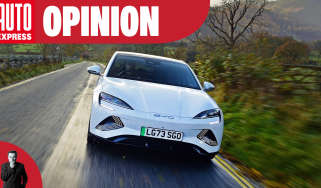Toyota C-HR GR Sport 2024 review: the hit crossover returns with new funky styling
The new C-HR is refined, well-equipped and good to drive, but it all comes at a cost

Verdict
The second-generation Toyota C-HR has great real-world efficiency, a nicely finished cabin, solid interior tech and enough of the funky styling touches that made the Mk1 such a hit. But this GR Sport version is probably the weakest of the breed, despite having the more potent of the powertrains. You’re paying a lot here for some styling add-ons and some extra power that might make the car more comfortable at speed, but does not add any greater involvement. We’d happily recommend the C-HR in general – but the sweet spot of the range is to be found elsewhere.
Toyota may be doubling down on full electrification in the medium term, but the company is still churning out full hybrids (very successfully) as more people look for a stepping stone towards a car with a plug. The Japanese brand recently refreshed one of its best-selling hybrids, the C-HR – and now it’s our first chance to try the more powerful 2.0-litre version of the car on UK roads.
As a reminder, the C-HR comes with a choice of 1.8 or 2.0-litre set-ups, each mated to the fifth generation of Toyota’s hybrid system. The lower-power car has a system output of 138bhp, and CO2 emissions of 111g/km. The 2.0, however, manages a punchier 194bhp, while still emitting the same amount of CO2. It’ll even return over 57mpg on the official WLTP test cycle.
Used - available now

2024 Volkswagen
Golf
48,352 milesAutomaticDiesel2.0L
Cash £19,700
2020 MINI
Countryman
46,628 milesAutomaticPetrol1.5L
Cash £10,000
2023 Land Rover
Discovery Sport
40,215 milesAutomaticPetrol1.5L
Cash £24,230
2018 MG
ZS
19,824 milesAutomaticPetrol1.0L
Cash £14,103The last of those numbers probably sounds respectable rather than stellar in this day and age, but it’s worth remembering that it’s an average – and Toyota actually reckons the car’s efficiency will improve in urban conditions, where a normal petrol car’s would suffer. And of course, this is a vehicle you never have to plug in – although should you feel you can benefit properly from PHEV tech, Toyota will offer a so-equipped version of the C-HR (for the first time) from later in 2024. In fact, order books are open now.
It’s probably best to take the C-HR’s dynamic behaviour in three distinct chunks. It’s at its best around town, where its relatively compact dimensions and pleasingly direct, responsive steering make it easy to manoeuvre through traffic. The ride is nicely judged, as we’ve come to expect from cars on the TNGA platform; it’s occasionally firm but generally well tied down, with enough compliance over urban bumps and potholes.
The hybrid system excels here too; there’s more than enough electric shove for the car to pull away smartly and in silence – and trundling around at 20mph or 30mph is absolutely in its comfort zone. As such, it’s not uncommon for the car to report that it has spent more than 70 per cent of short journeys running in its EV setting – and that’s with the powertrain left in Normal (rather than Eco) mode.
The difference between this C-HR and the last is that this good behaviour continues, in the most part, when you leave town and move on to faster country roads. The old model used to feel exposed here, with soaring revs dealt by the complex transmission at the heart of the hybrid system. But now it seems more comfortable with life.
We’d never go as far as to suggest there’s fun or real involvement to be had – ultimately there’s just too much going on between you and the engine itself for that – but it is possible to lean on the body control afforded by the TNGA underpinnings, use intelligent right-hand pedal inputs to make the transmission behave more like a conventional auto, and maintain genuinely swift progress.
Nor, it must be said, does this bring much of a trade-off in efficiency. The ‘EV percentage’ figure floats around a bit as you travel, but you can happily just go with the traffic flow, without thinking about driving particularly economically. On more than one occasion, we arrived at our destination and realised that the car had spent well over half the journey running on electricity alone.
As before, motorways are probably the C-HR’s weakest environment – though it’s far from unbearable, and at least one of the chinks in the armour is partially down to the GR Sport spec.
The hybrid system does give its usual surge of revs as you build up to speed to join traffic, but thereafter it settles to a respectable level, drowned out by a fair bit of wind noise from around the A-pillars and side mirrors. The worst offenders are the GR’s 20-inch rims, which transmit a fair amount of low-frequency noise up from the road surface beneath; we suspect a C-HR on 17s would be better behaved in this regard.
Inside, Toyota hasn’t deviated much from the stylised formula that scored such a success with the first C-HR. There’s a fully digital instrument panel, along with a whopping 12.3-inch infotainment system (lesser C-HRs make do with an eight-inch display), complete with wireless smartphone integration. There are thickly padded, quality plastics in all of the key areas, and sensible physical controls in the centre of the dash for ventilation and the heated seats.
However, the overall profile means that you still seem to sit in a different postcode from the base of the windscreen, and the rear seats are relatively short on legroom. Further to this, thanks to the small side windows and thick C-pillars, the back feels more than a little lacking in natural light.
It is desperately gloomy in there, as it was on the Mk1 C-HR; Toyota hasn’t really done anything to alleviate one of the car’s biggest flaws, but then it would have had to change the car’s fundamental positioning to do so. There’s still more space than you’ll find in many of the small SUVs from the likes of Fiat, Jeep, Peugeot and Vauxhall – and if you want proper five-seat practicality, your friendly Toyota salesperson will no doubt guide you towards the larger RAV4.
The C-HR’s boot is a fair size, at 364 litres – although as with the more conventional Corolla hatchback, you do pay a penalty in outright capacity for having the larger engine in the front. Relocating the 12-volt battery means that the GR Sport C-HR gives away just 20 litres of space compared with the regular 1.8, though, so it’s not exactly a deal-breaker.
Price may be more of an issue than the load bay, for the GR Sport is currently the only trim level where you can choose 2.0-litre power, and it comes with a fair premium. Over £40k is a chunk of change to pay for a car that isn’t as practical as many family hatchbacks, and probably no more efficient in the real world than the 1.8, which starts at around £10k less.
It might have more power, but it’s no more fun – and that leaves us wondering what you’re really spending the extra cash on here.
| Model: | Toyota C-HR GR Sport |
| Range from: | £31,290 |
| Model tested: | £41,625 |
| Powertrain: | 2.0-litre, 4cyl petrol hybrid |
| Power/torque: | 194bhp/190Nm |
| Transmission: | CVT auto, front-wheel drive |
| 0-62mph: | 8.1 seconds |
| Top speed: | 111mph |
| Economy: | 57.6mpg |
| CO2 emissions: | 111g/km |
| Dimensions (l/w/h): | 4,362/1,832/1,564mm |
| On sale: | Now |





